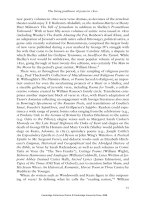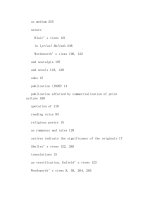The cambridge companion to british roman 37
Bạn đang xem bản rút gọn của tài liệu. Xem và tải ngay bản đầy đủ của tài liệu tại đây (39.46 KB, 1 trang )
The living pantheon of poets in 1820
new poetry volumes in 1820 were verse dramas, as devotees of the armchair
theater could enjoy T. F. Barham’s Abdallah; or, the Arabian Martyr or Henry
Hart Milman’s The Fall of Jerusalem in addition to Shelley’s Prometheus
Unbound.7 With at least fifty-seven volumes of satiric verse issued in 1820
(including Wooler’s The Kettle Abusing the Pot, Benbow’s Kouli Khan, and
an adaptation of Juvenal’s seventh satire called Patronage), political satire, a
genre only recently reclaimed for Romanticism, comprised the largest body
of new verse published during a year marked by George IV’s struggle with
his wife that came to be known as the Queen Caroline Affair, a dispute to
which Shelley added his Oedipus Tyrannus; or, Swellfoot the Tyrant. While
Shelley’s text would be withdrawn, the most popular volume of poetry in
1820, going through at least twenty-five editions, was certainly The Man in
the Moon by the period’s great satirist, William Hone.8
There was, as throughout the period, a fair sampling of religious poetry
(e.g., Paul Thackwell’s Collection of Miscellaneous and Religious Poems or
R. Willoughby’s The Plaintive Muse, or Poems Sacred to Religion), an important context for even the secularizing projects of a Hunt or a Shelley, and
a sizeable gathering of juvenile verse, including Poems for Youth, a collaborative volume created by William Roscoe’s family circle. Translation comprises another important block of verse in 1820, with Hunt’s adaptation of
Tasso’s Amyntas reflecting an engagement with foreign literatures also seen
in Bowring’s Specimens of the Russian Poets, and translations of Goethe’s
Faust, Foscolo’s Sepulchres, and Grillparzer’s Sappho. Readers could experience a wide range of poetic forms: odes ranging from the celebratory (e.g.,
A Pindaric Ode to the Genius of Britain by Charles Ethelston) to the satiric
(e.g. Odes to the Pillory); elegiac verses such as Margaret Sarah Croker’s
Monody on His Late Royal Highness the Duke of Kent and elegies on the
death of George III by Hemans and Mary Cockle (Shelley would publish his
elegy on Keats, Adonais, in 1821); epistolary poems (e.g., Joseph Cottle’s
An Expostulary Epistle to Lord Byron or John Wing’s Waterloo: A Poetical
Epistle to Mr. Sergeant Frere); and didactic works such as Elizabeth Hitchener’s Enigmas, Historical and Geographical and the Abridged History of
the Bible, in Verse by Sarah Richardson; as well as such volumes as Comic
Tales in Verse (by “The Two Franks”), Cottage Poems (William Wight),
Hebrew Harmonies and Analogies (William Coldwell), Lines Written at Jerpoint Abbey (Samuel Carter Hall), Sacred Lyrics (James Edmeston), and
Types of the Times (Old Tom of Oxford), not to mention Sultan Sham, and
His Seven Wives: An Historical, Romantic, Heroic Poem in Three Cantos by
Hudibras the Younger.
Where do writers such as Wordsworth and Keats figure in this outpouring of verse? In defining what he calls the “reading nation,”9 William
15
Cambridge Collections Online © Cambridge University Press, 2008









